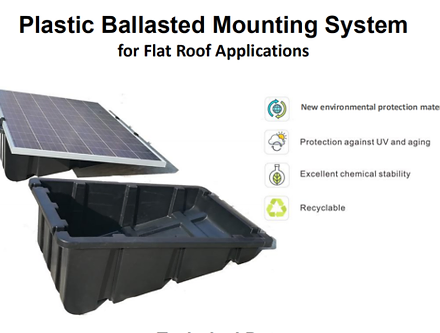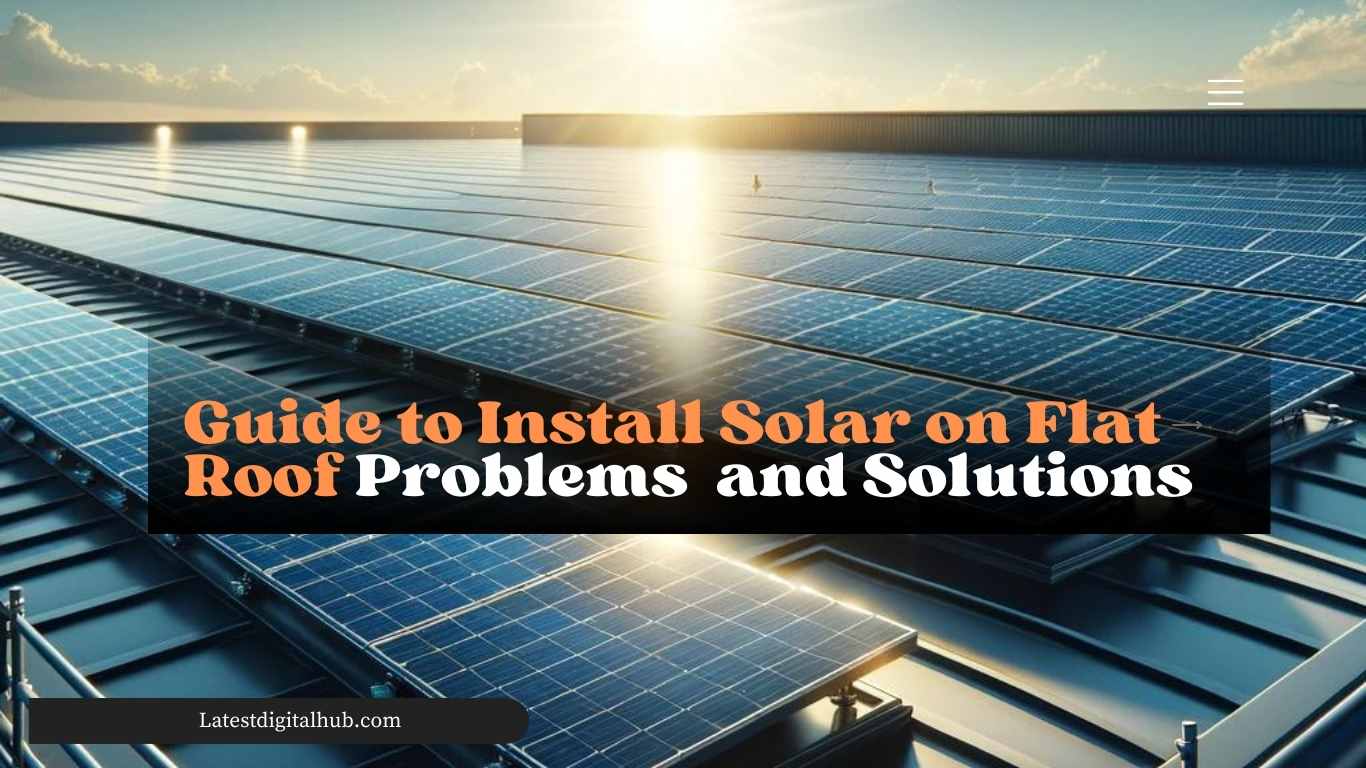Table of Contents
Installation of Solar Panels on Flat Roof
Before installing solar panels on a flat roof, it’s very important to carefully check if it’s a good idea and look closely at the site’s details. You need to see how much direct sunlight the roof gets because having a clear path for the sunlight is essential for the panels to work their best. Also, you have to ensure the roof is in good enough shape to handle the extra weight of the solar panel system.
| Step | Detail |
|---|---|
| 1. Feasibility and Site Assessment | Considering environmental loads, ensure the roof can support the additional weight of the solar panels. |
| 2. Mounting and Orientation | Use mounts to achieve the optimal tilt (30-45 degrees) and orientation (preferably south-facing in the Northern Hemisphere). |
| 3. Installation Types | Choose between ballasted mounting, mechanical attachment, or hybrid systems based on roof characteristics. |
| 4. Weight Considerations | Maintain proper drainage to prevent water from pooling beneath panels. |
| 5. Water Drainage | Maintain proper drainage to prevent water pooling beneath panels. |
| 6. Maintenance and Access | Allow space for maintenance and ensure easy access for cleaning and repairs. |
| 7. Regulations and Permissions | Check and comply with local building codes and zoning laws and obtain necessary permits. |
| 8. Cost and Incentives | Consider the installation cost and explore available incentives, tax breaks, and rebates. |
| 9. System Efficiency and Performance | System efficiency depends on installation angle, climate, and area shading; monitoring can optimize performance. |
| 10. Professional Assessment and Installation | Engage with a professional installer experienced with flat roofs for a tailored system design and installation. |
Problems With Solar Panels on Flat Roofs
Putting solar panels on flat roofs has its own set of problems, even though using solar energy is becoming more popular because it’s good for the environment and can save money. Installing them on flat roofs needs extra thought to dodge some common troubles. Let’s look at these problems and how to fix them.
Problem Water Pooling on Solar Panels
Flat roofs don’t slope much, which can lead to water gathering in places. Over time, this might cause leaks or damage, especially if installing solar panels messes with how water drains off the roof. To avoid this, it’s important to install everything correctly and with a good plan. Using tilt mounts to angle the panels helps water run off better and also catches more sunlight. It’s also very important to make sure the panels don’t block the way water usually leaves the roof.
Problem Wind Uplift on Solar Panels
Solar panels on flat roofs face more wind, which can lift them. This is a bigger problem in places with strong winds, as the wind might pull the panels off the roof. To prevent this, using wind blockers, making the panels heavier, or attaching them more firmly can really help lower the chance of them being lifted by the wind. Choosing a way to mount the panels that are made to withstand a lot of wind is a smart move, too.
Roof Weight Load Problem on Uplift Solar Panels
Solar panels’ additional weight and mounting systems can concern flat roofs, particularly older structures that may not have been designed to bear extra loads. Solution: A structural engineer should assess the roof’s load-bearing capacity before installation. Lightweight solar panels and mounting systems can fix and minimize this issue; in some cases, reinforcing the roof structure might be necessary.
Maintenance and Accessibility Problems on Uplift Solar Panels
Solar panel maintenance on flat roofs can be more challenging. Flat roofs require regular maintenance to ensure they remain in good condition, and the presence of solar panels can complicate access. This problem can be alleviated by strategically planning the layout of solar panels to ensure easy access for maintenance of both the panels and the roof itself. Regular inspections and maintenance schedules can help prevent major issues.
Mounting Solar Panels on Flat roof Without Drilling
While mounting solar panels on a flat roof without drilling is attractive for preserving the roof’s integrity, it’s important to weigh the pros and cons of each method. Considerations such as the roof’s structural capacity, environmental conditions, and long-term maintenance needs are crucial in determining the most suitable method.
Mounting solar panels on a flat roof without drilling encompasses various methods, each with its unique benefits and challenges. Weighted base systems, or ballasted mounting systems, avoid roof penetration, thus eliminating leak risks and allowing for relatively easy installation. However, they significantly increase the roof’s load, necessitating an evaluation of its structural capacity.
Adhesive mounting systems provide a drill-free solution with less weight added to the roof compared to ballasted systems, but their long-term durability can be affected by environmental conditions, and the bond may not be easily adjustable or removable once set.
Green roof integrated systems combine environmental benefits with solar panel installation, enhancing building insulation and aesthetics but requiring complex, potentially costly installations and ongoing maintenance. Non-penetrative clamps and edge mounts utilize the roof’s existing structures to secure panels without drilling, offering a minimal-risk option, though their feasibility and stability can vary based on the roof’s design and wind exposure.
Solar panel flat roof Tilt Mount
Flat roofs offer a unique opportunity for solar panel installation. Unlike pitched roofs, where the solar panels are installed parallel to the roof slope, flat roofs require a different approach to optimize solar energy capture. This is where tilt mount systems come into play. A tilt mount system allows solar panels to be installed at an optimal angle, regardless of the roof’s inherent angle, maximizing exposure to sunlight.
Spacing Between Solar Panels Flat Roof
When putting solar panels on a flat roof, it’s really important to consider how far apart the panels are to ensure they work as well as possible and avoid problems. The right amount of space stops one panel from shading another, especially in the morning and late afternoon when the sun is low and shadows are longer. This can make a big difference in how much electricity the panels generate.
Also, spacing them out helps air move around the panels, keeping them cooler. Since solar panels don’t work as well when they get too hot, cooler panels mean more electricity is produced.
Having enough room between panels also makes it easier to maintain them. You need space for cleaning, fixing, and regular maintenance, which helps the solar panel system last longer and stay efficient.
So, even though it might seem like a good idea to fill the roof with as many panels as possible, finding the right balance with spacing is key for a successful solar panel setup on a flat roof.
Distance between solar panels to avoid shading
The best distance between solar panels to avoid shading changes depends on several factors, such as location (latitude), tilt of the panels, time of year, and the height of some rows of panels. Shading can affect how well solar panels work because even a little shade on one panel can make the whole group of panels connected together produce less electricity.
To prevent panels from shading each other, it’s important to determine how far apart rows of panels should be. This means making sure that panels in one row don’t cast shadows on the panels in the next row, especially in the winter when the sun is lowest in the sky. This calculation usually considers the worst situation for how low the sun is, which happens around the winter solstice.
A general formula to estimate the minimum distance (D) between rows to avoid shading is:
D=H×tan(θ)
Where:
- D is the distance between the rows of panels,
- H is the height of the panels (or the height difference between the front of one row and the back of the next row),
- θ is the solar altitude angle at noon on the shortest day of the year.
This formula is just a basic guide. Remember, local conditions, like the exact place you’re in and anything that might block the sun (like buildings or trees), also matter. People often use software to determine how the sun moves and where shade might fall during the year. This helps plan the best setup for solar panels for a specific spot.
Since the perfect distance between panels can vary greatly based on these details, it’s a good idea to talk to an expert or use special software to take accurate measurements that fit your exact situation and setup needs.
Cost Estimation For Solar Panels on Flat Roofs
To provide cost estimation for a 5kW solar system on a flat roof using Akcome solar panels and including the price of an inverter, we’ll need to consider several components:
Cost of Solar Panels (Akcome)
The cost of solar panels can vary significantly depending on the model, efficiency, and the region where they are purchased. As of my last update, the price per watt for solar panels (including those from manufacturers like Akcome) typically ranges from $0.60 to $1.20 for residential installations. We’ll use an average cost for our calculations.
Inverter Cost
The inverter is a crucial component of any solar power system. It converts DC electricity generated by the solar panels into AC electricity that can be used by home appliances. The cost of an inverter depends on its capacity and brand. For a 5kW system, we’ll need to select an appropriately sized inverter.
Additional Components and Installation
Besides the panels and inverter, the total cost will also include mounting systems, wiring, connectors, and the cost of labor for installation. Costs can vary based on local labor rates and the complexity of the installation.
Let’s do a rough calculation based on these components:
Assuming an average price of $0.90 per watt, a 5kW system would require 5000 watts of solar panels. The cost for the panels alone would be 5000×0.905000×0.90 Inverter A good quality inverter for a 5kW system might cost anywhere from $1000 to $1500 Additional Components and Installation This can vary widely but typically ranges from $0.50 to $1.00 per watt, including labor, mounting systems, and other components.
Solar Panel Flat Roof Kit

Selecting the “best” solar panel kit for a flat roof depends on several factors, including the size of the system you need (in kW), your budget, the available space on your roof, and your energy consumption needs. However, a high-quality solar panel kit for a flat roof typically includes efficient solar panels, a reliable inverter, mounting hardware designed for flat roofs, and sometimes additional components like monitoring systems check out this kit Flat Roof Ground Mounting Solar PV Panel Kit 1/2/3/4/10
FAQ
Can I install solar panels on a flat roof?
Yes, solar panels can be installed on a flat roof. This type of installation might involve tilting the panels to optimize sunlight exposure.
Are the costs of installing solar panels on a flat roof higher than on a pitched roof?
The costs of installing solar panels on a flat roof are comparable to those for a typical pitched roof installation.
Do solar panels on a flat roof need to be tilted?
Solar panels on a flat roof may or may not be tilted, depending on the specific requirements and goals of the solar installation.

